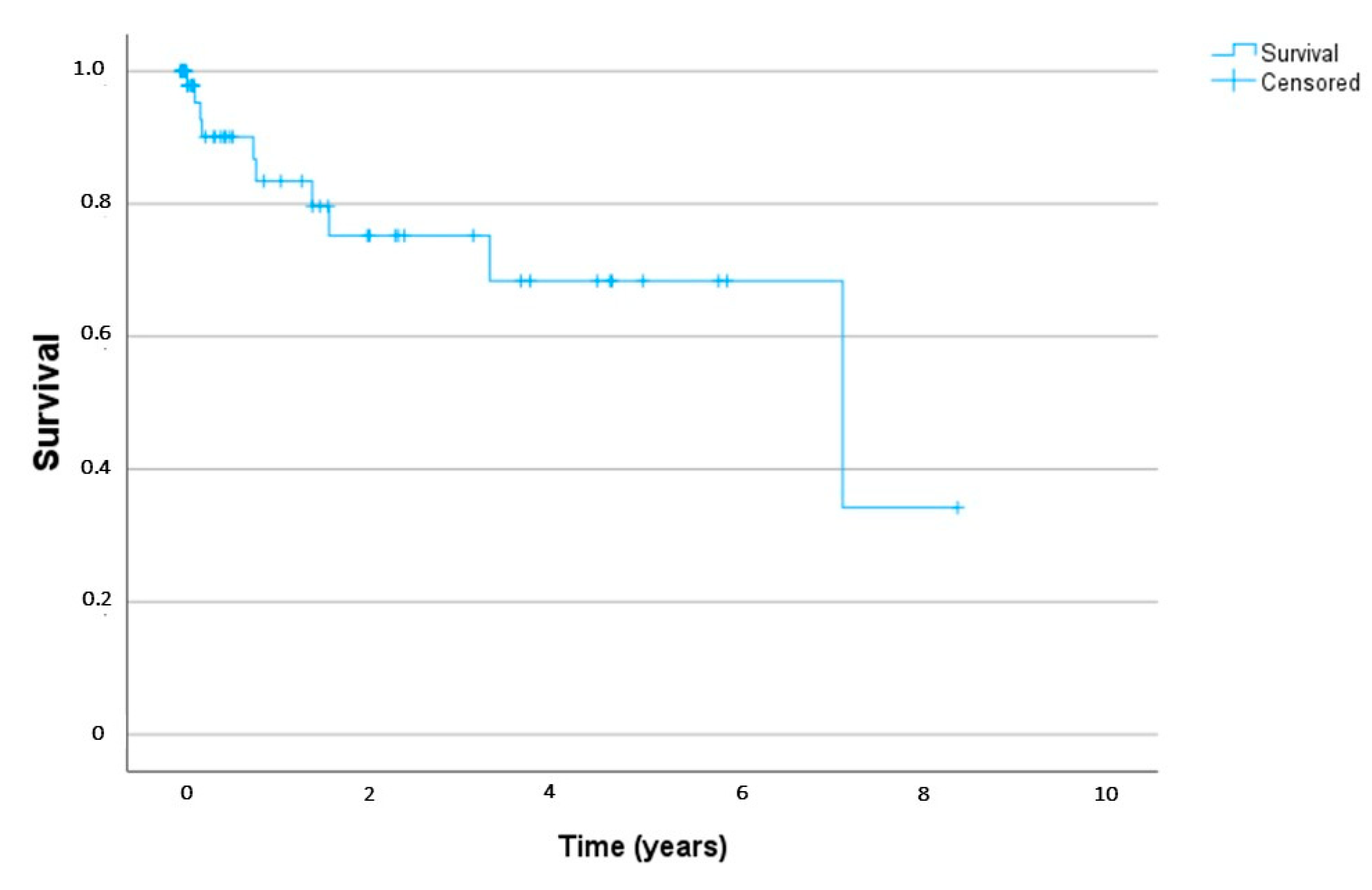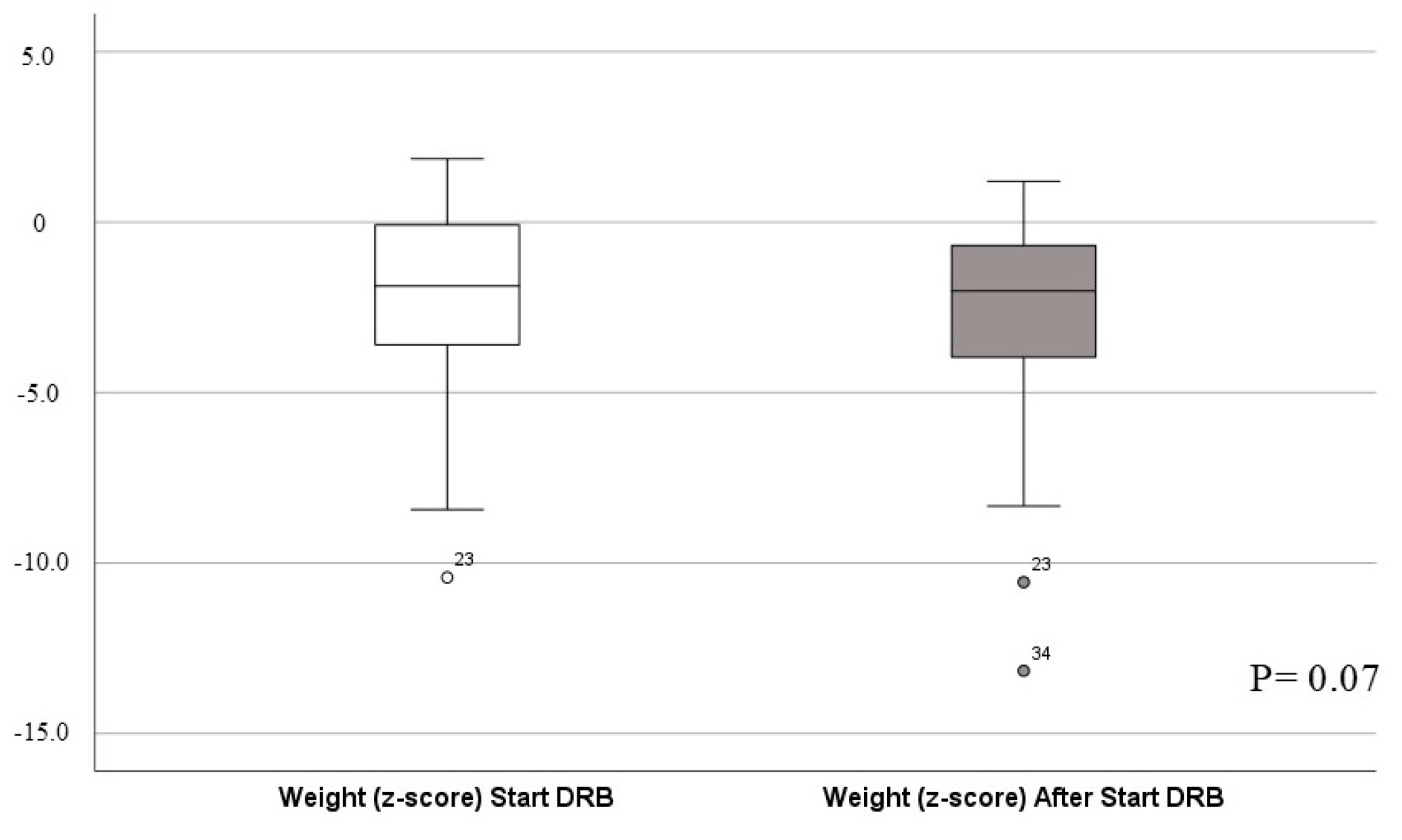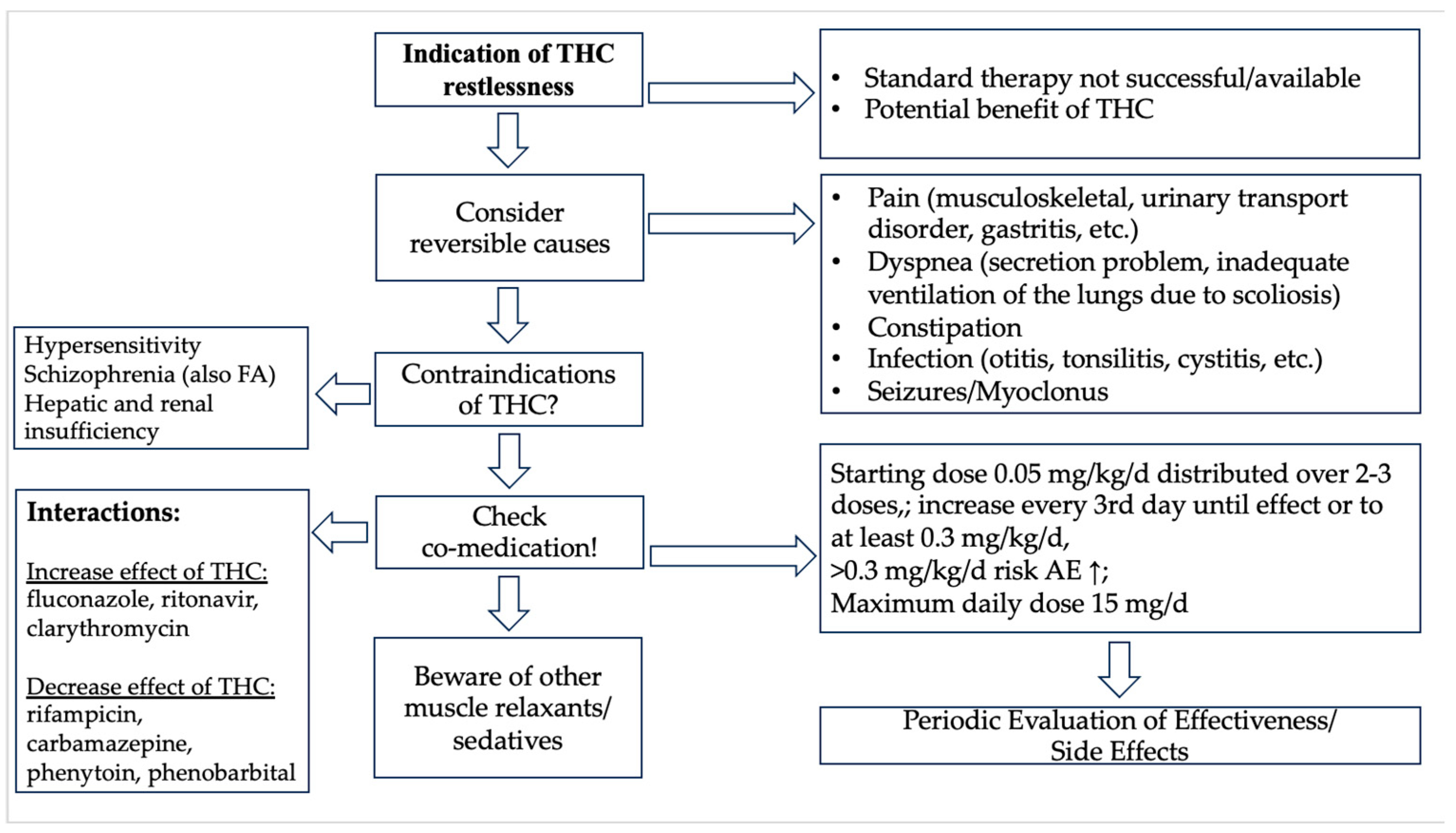Dronabinol Is Not a Game Changer in Pediatric Palliative Care: Results from a Retrospective Study
Abstract
1. Introduction
2. Patients and Methods
2.1. Patient Data
2.2. Effects of Dronabinol
2.3. Side Effects
2.4. Follow-Up
2.5. Data Collection and Statistics
3. Results
3.1. Demographics
3.2. Treatment
3.3. Efficacy
3.4. Side Effects
3.5. Case Descriptions
3.5.1. Case 22
3.5.2. Case 25
3.5.3. Case 35
3.6. Outcome
4. Discussion
4.1. Limitations
4.2. Proposal for a Standard DRB-Treatment of Restlessness
5. Conclusions
Author Contributions
Funding
Institutional Review Board Statement
Informed Consent Statement
Data Availability Statement
Acknowledgments
Conflicts of Interest
References
- Manthey, J.; Freeman, T.P.; Kilian, C.; López-Pelayo, H.; Rehm, J. Public health monitoring of cannabis use in Europe: Prevalence of use, cannabis potency, and treatment rates. Lancet Reg. Health Eur. 2021, 10, 100227. [Google Scholar] [CrossRef]
- Das Bundesinstitut für Arzneimittel und Medizinprodukte (BfArM). Abschlussbericht der Begleiterhebung nach § 31 Absatz 6 des Fünften Buches Sozialgesetzbuch zur Verschreibung und Anwendung von Cannabisarzneimitteln; Das Bundesinstitut für Arzneimittel und Medizinprodukte (BfArM): Bonn, Germany, 2022. [Google Scholar]
- Federal Statistical Office: Sales of Medical Cannabinoids in the Year 2022. Available online: https://de.statista.com/statistik/daten/studie/1278747/umfrage/gkv-umsatz-mit-cannabinoidhaltigen-arzneimitteln-in-deutschland/#:~:text=Im%20Jahr%202022%20beliefen%20sich,Cannabis-Blüten%20in%20unverändertem%20Zustand (accessed on 27 August 2024).
- German Gouvernement. Legal Code „Medizinal-Cannabis-Gesetz“; 27.03.2024 BGBl. 2024 I Nr. 109, S. 27; German Gouvernement: Berlin, Germany, 2024. [Google Scholar]
- Hauch, H.; Klinkel, N.; Chao, C.M.; Behrje, J.; Kreuzaler, P.; Bagheri, A.; Sibelius, U.; Berthold, D. Constitution of a New Specialised Pediatric Home Care Team—First Year Experience. Klin. Padiatr. 2016, 228, 145–148. [Google Scholar]
- Nolte-Buchholtz, S.; Zernikow, B.; Wager, J. Pediatric Patients Receiving Specialized Palliative Home Care According to German Law: A Prospective Multicenter Cohort Study. Children 2018, 5, 66. [Google Scholar] [CrossRef] [PubMed]
- Treves, N.; Mor, N.; Allegaert, K.; Bassalov, H.; Berkovitch, M.; Stolar, O.E.; Matok, I. Efficacy and safety of medical cannabinoids in children: A systematic review and meta-analysis. Sci. Rep. 2021, 11, 23462. [Google Scholar] [CrossRef]
- Chan, H.S.; Correia, J.A.; MacLeod, S.M. Nabilone versus prochlorperazine for control of cancer chemotherapy-induced emesis in children: A double-blind, crossover trial. Pediatrics 1987, 79, 946–952. [Google Scholar] [PubMed]
- Efron, D.; Taylor, K. Medicinal Cannabis for Paediatric Developmental, Behavioural and Mental Health Disorders. Int. J. Environ. Res. Public Health 2023, 20, 5430. [Google Scholar] [CrossRef]
- Aran, A.; Harel, M.; Cassuto, H.; Polyansky, L.; Schnapp, A.; Wattad, N.; Shmueli, D.; Golan, D.; Castellanos, F.X. Cannabinoid treatment for autism: A proof-of-concept randomized trial. Mol. Autism 2021, 12, 6. [Google Scholar] [CrossRef] [PubMed]
- Kuhlen, M.; Hoell, J.I.; Gagnon, G.; Balzer, S.; Oommen, P.T.; Borkhardt, A.; Janßen, G. Effective treatment of spasticity using dronabinol in pediatric palliative care. Eur. J. Paediatr. Neurol. 2016, 20, 898–903. [Google Scholar] [CrossRef] [PubMed]
- Wilson, J.L.; Gregory, A.; Wakeman, K.; Freed, A.; Rai, P.; Roberts, C.; Hayflick, S.J.; Hogarth, P. Cannabis Use in Children With Pantothenate Kinase-Associated Neurodegeneration. J. Child. Neurol. 2020, 35, 259–264. [Google Scholar] [CrossRef]
- Doherty, M.; Power, L.; Attala, M.; Vadeboncoeur, C. Use of oral cannabis extracts in the pediatric palliative care setting: A retrospective chart review. Palliat. Med. 2020, 34, 435–437. [Google Scholar] [CrossRef]
- Fairhurst, C.; Kumar, R.; Checketts, D.; Tayo, B.; Turner, S. Efficacy and safety of nabiximols cannabinoid medicine for paediatric spasticity in cerebral palsy or traumatic brain injury: A randomized controlled trial. Dev. Med. Child. Neurol. 2020, 62, 1031–1039. [Google Scholar] [CrossRef] [PubMed]
- Zürcher, K.; Dupont, C.; Weber, P.; Grunt, S.; Wilhelm, I.; Eigenmann, D.E.; Reichmuth, M.L.; Fankhauser, M.; Egger, M.; Fenner, L. Use and caregiver-reported efficacy of medical cannabis in children and adolescents in Switzerland. Eur. J. Pediatr. 2022, 181, 335–347. [Google Scholar] [CrossRef] [PubMed]
- Braun, I.M.; Bohlke, K.; Abrams, D.I.; Anderson, H.; Balneaves, L.G.; Bar-Sela, G.; Bowles, D.W.; Chai, P.R.; Damani, A.; Gupta, A.; et al. Cannabis and Cannabinoids in Adults With Cancer: ASCO Guideline. J. Clin. Oncol. 2024, 42, 1575–1593. [Google Scholar] [CrossRef]
- Kromeyer-Hauschild, K.; Wabitsch, M.; Kunze, D.; Geller, F.; Geiß, H.C.; Hesse, V.; von Hippel, A.; Jaeger, U.; Johnsen, D.; Korte, W.; et al. Perzentile für den Body-mass-Index für das Kindes- und Jugendalter unter Heranziehung verschiedener deutscher Stichproben. Monatsschrift Kinderheilkd. 2001, 149, 807–818. [Google Scholar] [CrossRef]
- Hoell, J.I.; Weber, H.; Warfsmann, J.; Trocan, L.; Gagnon, G.; Danneberg, M.; Balzer, S.; Keller, T.; Janßen, G.; Kuhlen, M. Facing the large variety of life-limiting conditions in children. Eur. J. Pediatr. 2019, 178, 1893–1902. [Google Scholar] [CrossRef] [PubMed]
- Dreier, L.A.; Angenendt, N.; Hasan, C.; Zernikow, B.; Wager, J. Potential Contributing Factors for Irritability of Unknown Origin in Pediatric Palliative Care. J. Pain. Symptom. Manag. 2022, 64, 156–167. [Google Scholar] [CrossRef]
- World Health Organization. The Use of the WHO-UMC System for Standardised Case Causality Assessment; World Health Organization: Geneva, Switzerland, 2024. [Google Scholar]
- Benjamini, Y.H.Y. Discovery Rate: A Practical and Powerful Approach to Multiple Testing. J. R. Stat. Soc. Ser. B 1995, 57, 289–300. [Google Scholar] [CrossRef]
- Cohen, J. Statistical Power Analysis for the Behavioral Sciences, 2nd ed.; L. Erlbaum Associates: Mahwah, NJ, USA, 1988. [Google Scholar]
- Vandenbroucke, J.P.v.E.E.; Altman, D.G.; Gøtzsche, P.C.; Mulrow, C.D.; Pocock, S.J.; Poole, C.; Schlesselman, J.J.; Egger, M. STROBE Initiative. Strengthening the Reporting of Observational Studies in Epidemiology (STROBE): Explanation and elaboration. PLoS Med. 2007, 4, e297. [Google Scholar] [CrossRef]
- Divisic, A.; Avagnina, I.; De Tommasi, V.; Santini, A.; Brogelli, L.; Giacomelli, L.; Benini, F. The use of medical cannabis in pediatric palliative care: A case series. Ital. J. Pediatr. 2021, 47, 229. [Google Scholar] [CrossRef]
- Libzon, S.; Schleider, L.B.; Saban, N.; Levit, L.; Tamari, Y.; Linder, I.; Lerman-Sagie, T.; Blumkin, L. Medical Cannabis for Pediatric Moderate to Severe Complex Motor Disorders. J. Child. Neurol. 2018, 33, 565–571. [Google Scholar] [CrossRef]
- Himmelmann, K.; Hagberg, G.; Beckung, E.; Hagberg, B.; Uvebrant, P. The changing panorama of cerebral palsy in Sweden. IX. Prevalence and origin in the birth-year period 1995–1998. Acta Paediatr. 2005, 94, 287–294. [Google Scholar] [CrossRef] [PubMed]
- Romeo, D.M.; Sini, F.; Brogna, C.; Albamonte, E.; Ricci, D.; Mercuri, E. Sex differences in cerebral palsy on neuromotor outcome: A critical review. Dev. Med. Child. Neurol. 2016, 58, 809–813. [Google Scholar] [CrossRef] [PubMed]
- Vasileiadis, G.T.; Thompson, R.T.; Han, V.K.; Gelman, N. Females follow a more “compact” early human brain development model than males. A case-control study of preterm neonates. Pediatr. Res. 2009, 66, 551–555. [Google Scholar] [CrossRef] [PubMed]
- Reiss, A.L.; Kesler, S.R.; Vohr, B.; Duncan, C.C.; Katz, K.H.; Pajot, S.; Schneider, K.C.; Makuch, R.W.; Ment, L.R. Sex differences in cerebral volumes of 8-year-olds born preterm. J. Pediatr. 2004, 145, 242–249. [Google Scholar] [CrossRef] [PubMed]
- Tagsold, D.; Toni, I.; Trollmann, R.; Woelfle, J.; Gravou-Apostolatou, C. The Use of Cannabinoids in Pediatric Palliative Care-A Retrospective Single-Center Analysis. Children 2024, 11, 234. [Google Scholar] [CrossRef]
- Moore, A.; Karadag, P.; Fisher, E.; Crombez, G.; Straube, S.; Eccleston, C. Narrative bias (“spin”) is common in randomised trials and systematic reviews of cannabinoids for pain. Pain 2024, 165, 1380–1390. [Google Scholar] [CrossRef]
- Gardner, E.B. Effects of “Cannabis Sativa”. Ind. Med. Gaz. 1866, 1, 274. [Google Scholar]
- Mak, R.H. Cachexia in children with chronic kidney disease: Challenges in diagnosis and treatment. Curr. Opin. Support. Palliat. Care 2016, 10, 293–297. [Google Scholar] [CrossRef]
- Fatmi, Z.; White, F. A comparison of ‘cough and cold’ and pneumonia: Risk factors for pneumonia in children under 5 years revisited. Int. J. Infect. Dis. 2002, 6, 294–301. [Google Scholar] [CrossRef][Green Version]
- Rodriguez-Key, M.; Alonzi, A. Nutrition, skin integrity, and pressure ulcer healing in chronically ill children: An overview. Ostomy Wound Manag. 2007, 53, 56–58; 60, 62, passim. [Google Scholar]
- Cai, S.; Guo, Q.; Wang, X.; Wang, R.; Yang, P.; Zhou, Y.; Luo, Y.; Zhou, X.; Peng, X. Development levels of pediatric palliative care teams and the extent of palliative care understanding and implementation among pediatric oncologists in China. Pediatr. Investig. 2021, 5, 265–270. [Google Scholar] [CrossRef] [PubMed]
- Scheffler, F.; Kilian, S.; Chiliza, B.; Asmal, L.; Phahladira, L.; du Plessis, S.; Kidd, M.; Murray, R.M.; Di Forti, M.; Seedat, S.; et al. Effects of cannabis use on body mass, fasting glucose and lipids during the first 12 months of treatment in schizophrenia spectrum disorders. Schizophr. Res. 2018, 199, 90–95. [Google Scholar] [CrossRef] [PubMed]
- Razmovski-Naumovski, V.; Luckett, T.; Amgarth-Duff, I.; Agar, M.R. Efficacy of medicinal cannabis for appetite-related symptoms in people with cancer: A systematic review. Palliat. Med. 2022, 36, 912–927. [Google Scholar] [CrossRef] [PubMed]
- Martin-Santos, R.; Crippa, J.A.; Batalla, A.; Bhattacharyya, S.; Atakan, Z.; Borgwardt, S.; Allen, P.; Seal, M.; Langohr, K.; Farré, M.; et al. Acute effects of a single, oral dose of d9-tetrahydrocannabinol (THC) and cannabidiol (CBD) administration in healthy volunteers. Curr. Pharm. Des. 2012, 18, 4966–4979. [Google Scholar] [CrossRef]
- Denton, E.E.; Jung, S.S.; Ventura, C.A.I. Clinical Diagnosis and Management of Gradual Onset Cannabis-Induced Psychosis Following the Consumption of Delta-8-Tetrahydrocannabinol. Cureus 2024, 16, e55464. [Google Scholar] [CrossRef] [PubMed]



| Patients | N | 63 |
|---|---|---|
| Gender | Female: Male: | 36.5% 63.5% |
| Age Mean/SD Age Median | 10.4 (SD 6.3) years 9.3 years | |
| Palliative Groups: | TfSL-1: | 4.8% |
| TfSL-2: | 1.6% | |
| TfSL-3: | 24.2% | |
| TfSL-4: | 69.4% | |
| Disease Groups: | Neurologic disease: • Hypoxic: • Metabolic: • Malformation: • Epileptic syndrome: • Combination/Unclear: • Tumor: No neurologic disease: | 34.9% 25.4% 23.8% 6.3% 3.2% 3.2% 3.2% |
| Co-Morbidity: | Psychomotor Retardation: | 92.1% |
| Epilepsy: | 92.1% | |
| Cerebral Palsy: | 88.9% | |
| Respirator Therapy: | 3.2% | |
| Co-Medication to Dronabinol: | Antiepileptic Drugs (AED): Number of AED (mean/SD): Benzodiazepines: Opiates: Skeletal Muscle Relaxants: Other Sedatives: Cannabidiol (counted as AED also): | 92.1% 1.95 (SD 1.03) 28.6% 30.2% 50.8% 15.9% 4.8% |
| Start Dronabinol in Hospital | Adjusted p-Value b | Effect Size c | ||||
|---|---|---|---|---|---|---|
| Yes (=A) N = 26 | No (=B) N = 37 | p-Value a | ||||
| Indication DRB | Spasticity: Restlessness: Dystonia: Pain: Seizures: Myoclonus: | 18 (69.2%) 19 (73.1%) 6 (23.1%) 11 (42.3%) 5 (19.2%) 3 (11.5%) | 24 (64.9%) 26 (70.3%) 1 (2.7%) 25 (67.6%) 6 (16.2%) 3 (8.1%) |  | n/a | n/a |
| Start DRB after (A)/before admission (B) | (mean/SD): Median: | 10.1/7.0 8 | 174/137 136 | n/a | n/a | n/a |
| Dosage DRB (mg/kg BW/day) (mean/SD) | Starting dosage: Effective dosage: Last dosage: Dosing Steps: | 0.06/0.21 0.21/0.11 0.25/0.21 3.12/1.12 | n/a 0.48/0.50 0.46/0.49 n/a | n/a 0.007 0.013 n/a | n/a 0.01 0.01 n/a | n/a 0.330 0.300 n/a |
| Treatment period (days) | (mean/SD): Median: | 739/939 259 | 369/390 240 | 0.939 | 0.939 | 0.008 |
| Follow-up (month) | Median: Range: | 16.6 0.5–100.9 | 1.8 0.2–48.2 | 0.001 | 0.004 | 0.320 |
| Patient-Number/Age | Description | Dosage at Time of Event (mg/kgBW/day) | Co-Medications Modified | Course | Late Sequelae |
|---|---|---|---|---|---|
| 22/ 13 y, 0 m | Day 3 after start of DRB: Respiratory insufficiency Oxygen-Inhalation | 0.09 | No | Resolution after stopping and withdrawal of DRB | no |
| 25/ 1 y, 6 m | Day 14 after start of DRB: Respiratory insufficiency Non-invasive ventilation | 0.3 | No | Resolution after stopping and withdrawal of DRB | no |
| 35/ 9 y, 6 m | Day 12 after start of DRB: Respiratory rate reduced | 0.25 | No | Resolution after stopping and withdrawal of DRB | no |
Disclaimer/Publisher’s Note: The statements, opinions and data contained in all publications are solely those of the individual author(s) and contributor(s) and not of MDPI and/or the editor(s). MDPI and/or the editor(s) disclaim responsibility for any injury to people or property resulting from any ideas, methods, instructions or products referred to in the content. |
© 2024 by the authors. Licensee MDPI, Basel, Switzerland. This article is an open access article distributed under the terms and conditions of the Creative Commons Attribution (CC BY) license (https://creativecommons.org/licenses/by/4.0/).
Share and Cite
Hauch, H.; Lisakowski, A.; Wager, J.; Zernikow, B. Dronabinol Is Not a Game Changer in Pediatric Palliative Care: Results from a Retrospective Study. Children 2024, 11, 1054. https://doi.org/10.3390/children11091054
Hauch H, Lisakowski A, Wager J, Zernikow B. Dronabinol Is Not a Game Changer in Pediatric Palliative Care: Results from a Retrospective Study. Children. 2024; 11(9):1054. https://doi.org/10.3390/children11091054
Chicago/Turabian StyleHauch, Holger, Annika Lisakowski, Julia Wager, and Boris Zernikow. 2024. "Dronabinol Is Not a Game Changer in Pediatric Palliative Care: Results from a Retrospective Study" Children 11, no. 9: 1054. https://doi.org/10.3390/children11091054
APA StyleHauch, H., Lisakowski, A., Wager, J., & Zernikow, B. (2024). Dronabinol Is Not a Game Changer in Pediatric Palliative Care: Results from a Retrospective Study. Children, 11(9), 1054. https://doi.org/10.3390/children11091054









